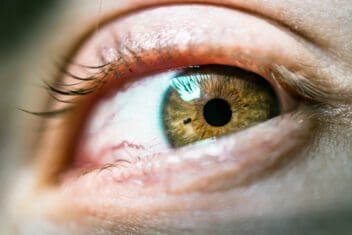
Medically Reviewed by Iga Gray, M.D. NVISION Surgeon
Narrow Angle Glaucoma: Causes, Symptoms & Treatment
Home / Diagnosed With Glaucoma /
Last Updated:

Medically Reviewed by Iga Gray, M.D. NVISION Surgeon

Article At a Glance
Narrow-angle glaucoma happens when the space between the iris and cornea is too tight, causing sudden spikes in eye pressure. It can lead to severe eye pain, headaches, nausea, and rapid vision loss—making it a true medical emergency. Unlike open-angle glaucoma, symptoms are noticeable and require immediate care.
Treatments may include laser procedures or surgery to widen the drainage angle and prevent future attacks. If you’re at risk or experience sudden eye symptoms, don’t wait—early intervention is key to protecting your vision.
Table of Contents
Narrow-Angle Glaucoma (also called closed-angle glaucoma) is a type of glaucoma caused by the closing of a drainage angle that allows for the normal transport of fluid between the iris and the lens of the eye.
When the drainage angle is blocked, it results in an increase of pressure in the eye. This can damage the optic nerve and cause severe damage and even blindness.
Narrow-angle glaucoma isn’t a common type of glaucoma. It makes up less than 10 percent of total glaucoma diagnosis. However, the prevalence of narrow-angle glaucoma varies significantly across different populations. For instance, in Asian populations, narrow-angle glaucoma is more prevalent, comprising a larger proportion of glaucoma cases compared to other ethnic groups.
What Is Narrow-Angle Glaucoma?

The eye is filled with a fluid called aqueous humor. A drainage system allows this fluid to enter and exit your eye in equal amounts. This ensures that your eye receives proper nourishment and maintains its shape.
Narrow-angle glaucoma is caused by a buildup of fluid in the eye due to a closure of a passageway (a narrow angle) that the fluid usually flows through in order to travel between the lens and iris of the eye.
You deserve clear vision. We can help.
With 135+ locations and over 2.5 million procedures performed, our board-certified eye surgeons deliver results you can trust.
Your journey to better vision starts here.
Glaucoma is a group of eye conditions that damages the optic nerve. If aqueous humor doesn’t stay balanced within the eye, excess intraocular pressure (IOP) builds up. This pressure can lead to optic nerve damage.
Types of Glaucoma
There are two major types of glaucoma: open-angle and narrow-angle.
- Open-Angle Glaucoma: Open-Angle Glaucoma is caused by a blockage to drainage of one of the canals, called the trabecular meshwork. This causes increased pressure that harms the optic nerve.
- Narrow-Angle Glaucoma: This type occurs when the iris blocks the drainage angles in the eye. In narrow-angle glaucoma, fluid cannot travel through the eye, and pressure can quickly build up.
Symptoms of Acute Narrow-Angle Glaucoma
All forms of glaucoma are serious, but acute narrow-angle glaucoma is a medical emergency.

Some people may not know they have it, and symptoms can suddenly appear.
Intraocular pressure (IOP) can suddenly rise within the eye, leading to a condition known as acute narrow-angle glaucoma. This type of glaucoma is a medical emergency and requires immediate treatment to prevent severe vision loss or even blindness.
Look out for these symptoms of acute narrow-angle glaucoma:
- Nausea
- Pain in the eye
- Eye redness
- Blurry vision
- Headache
- Dilated pupils
- Halos that encircle lights
If these symptoms are present, it’s imperative to seek emergency care to prevent blindness. Every moment counts.
What Causes Narrow Angle Glaucoma?
The iris is the colored part of the eye around the pupil. When the iris moves forward, it narrows the space between the cornea and the iris. This is where the eye’s drainage angle is.
When this space is narrowed, fluid can build up and pressure in the eye is increased. This can damage the optic nerve and lead to vision loss and blindness.
You deserve clear vision. We can help.
With 135+ locations and over 2.5 million procedures performed, our board-certified eye surgeons deliver results you can trust.
Your journey to better vision starts here.
Risk Factors for Narrow-Angle Glaucoma
Some risk factors can increase the likelihood of developing narrow-angle glaucoma. You have a higher risk of developing glaucoma if you fit these criteria:
- You have diabetes
- You are 60 or older
- You are a woman
- You are of Inuit or Asian descent
- You have a past history of cataracts
- You are farsighted
- You used steroids regularly in the past
- You have a history of eye injuries
- You have a family history of glaucoma
How is Narrow-Angle Glaucoma Diagnosed?
Consistent eye exams are the best way to prevent or detect narrow-angle glaucoma before symptoms become severe. A qualified ophthalmologist will conduct the following tests to diagnose glaucoma:
- Tonometry: This test measures eye pressure.
- Perimetry: This exam measures your field of vision.
- Ophthalmoscopy: This is an optic nerve evaluation.
- Gonioscopy: This is an eye drainage inspection.
These tests will not be conducted during every visit, and they are not all necessary for everyone. If you already have glaucoma, these tests can measure whether or not it has progressed or if treatment is working. Be prepared to discuss your family history of glaucoma or other medical conditions during visits.
Are Treatments Available for Narrow-Angle Glaucoma?
Narrow-angle glaucoma can be successfully managed if detected early. Treatment can include one or more of the following:
Eye drops: These are meant to relieve eye pressure or decrease production of aqueous fluid. Their purpose is to preserve your eyesight, but they can cause some side effects, such as:
- Blurry vision.
- Dry mouth.
- Itching or stinging.
- Changes to your heart rate.
- Changes in energy levels.
- Fluctuations in breathing.
Oral medication: Typically, you will have a prescription for a carbonic anhydrase inhibitor. This can decrease pressure if your eye drops are not doing this on their own. Side effects of this medication include:
- Upset stomach.
- Kidney stones.
- Tingling in the fingers and toes.
- Increased urination.

Laser surgery: This can be performed in an outpatient center or ophthalmologist’s office. People with narrow-angle glaucoma can get an iridotomy. Your surgeon will use a laser to make a small opening in the iris to facilitate drainage. This then reduces pressure in the eyes.
Surgery: This is performed in a traditional operating room. A surgeon will use special instruments to create a new drainage channel for your eye to relieve pressure. There are two types of surgery for glaucoma.
- Trabeculectomy: Your surgeon will cut a small flap in the white part of the eye. This will be done under the eyelid, and it is discreet. The flap will lead to a filtration bleb that allows for better eye drainage to relieve pressure that harms your optic nerve.
- Drainage implant, or glaucoma drainage device: In this surgery, your physician will implant a small tube in your eye and create a reservoir that allows aqueous fluid to collect there. Your blood vessels absorb the fluid as it exits the eye.
The good news is that treatment can slow the progression of narrow-angle glaucoma and prevent vision loss. Studies show that cases of blindness caused by glaucoma have decreased since metrics for diagnosis were changed in 1981 and 2000. Treatments have also improved, allowing people to manage their condition much better than in the past.
Consistent eye exams can help you detect narrow-angle glaucoma early, and early treatment is key to a better long-term prognosis. With ever-advancing diagnostic and treatment technology, glaucoma is much less likely to lead to significant or complete loss of sight. In the majority of cases, it can be effectively managed with the right care.
You deserve clear vision. We can help.
With 135+ locations and over 2.5 million procedures performed, our board-certified eye surgeons deliver results you can trust.
Your journey to better vision starts here.
References
- Glaucoma. (July 2019). National Eye Institute.
- Glaucoma Treatment. (August 2019). American Academy of Ophthalmology.
- Glaucoma. Kellogg Eye Center, University of Michigan.
- What Are Symptoms of Glaucoma? (May 2019). American Academy of Ophthalmology.
- Eye Anatomy. (October 2017). Glaucoma Research Foundation.
- The Best Approach for Narrow Angle Patients. (May 2022). Review of Ophthalmology.

Dr. Iga N. Gray is a comprehensive ophthalmologist with a specialization in glaucoma, currently practicing at Alvarado Eye Associates in San Diego, California. Prior to that, she worked at Philadelphia Eye Associates and was affiliated with Wills Eye Hospital and the University of Pennsylvania’s Scheie Eye Institute, where she completed her glaucoma fellowship and ophthalmology residency.
This content is for informational purposes only. It may have been reviewed by a licensed physician, but is not intended to serve as a substitute for professional medical advice. Always consult your healthcare provider with any health concerns. For more, read our Privacy Policy and Editorial Policy.

